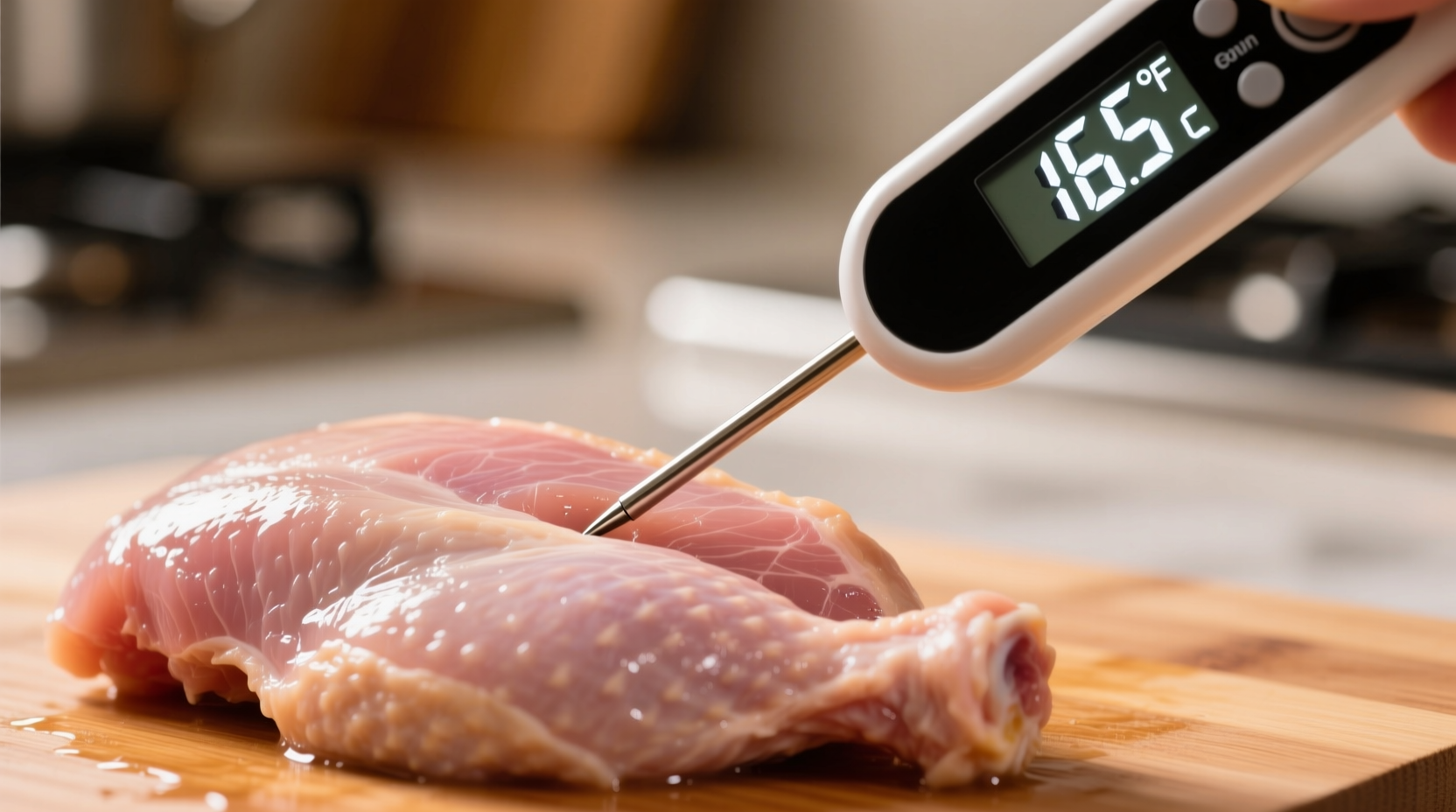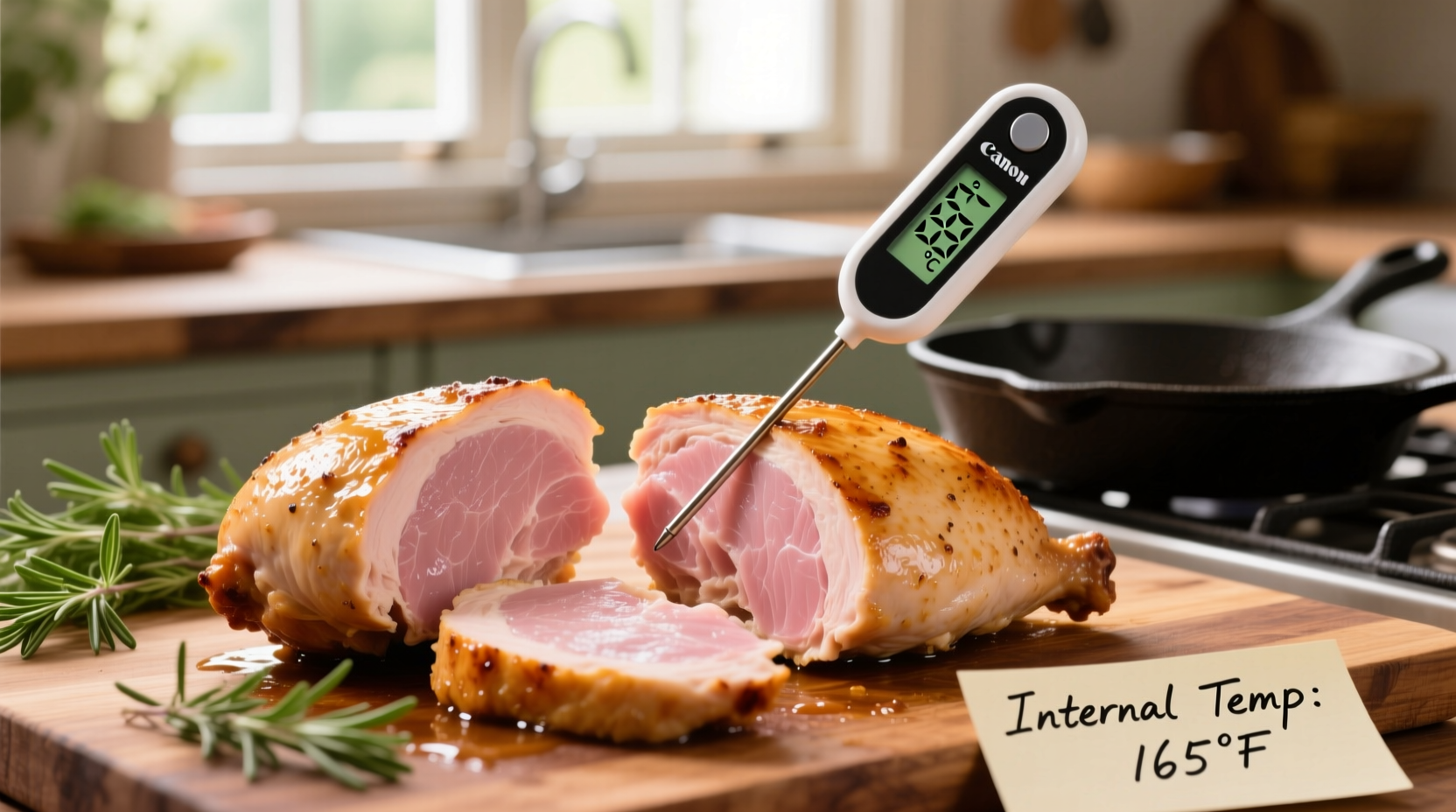The safe internal temperature for cooked chicken is 165°F (74°C) as measured by a food thermometer in the thickest part of the meat. This temperature destroys harmful bacteria like Salmonella and Campylobacter, ensuring your chicken is both safe to eat and properly cooked.
Getting chicken temperature right isn't just about safety—it's the difference between dry, overcooked poultry and juicy, flavorful results. As a home cook, you deserve to know exactly when your chicken has reached that perfect balance of food safety and culinary excellence.
Why 165°F Is Non-Negotiable for Chicken Safety
Understanding the science behind chicken cooking temperatures transforms how you approach meal preparation. The USDA Food Safety and Inspection Service (FSIS) established 165°F as the minimum safe temperature because this specific heat level destroys dangerous pathogens including:
- Salmonella - Causes severe gastrointestinal illness
- Campylobacter - Leading cause of bacterial foodborne illness
- Clostridium perfringens - Creates toxins when chicken cools improperly
These bacteria don't produce visible signs of contamination, making temperature measurement the only reliable safety check. Relying on color or texture alone puts you at risk—undercooked chicken might appear done while still harboring dangerous bacteria.
Your Step-by-Step Temperature Guide for Perfect Chicken
1. Selecting and Using the Right Thermometer
Not all thermometers deliver accurate results. For precise chicken temperature readings:
- Use an instant-read digital thermometer (tested to ±0.5°F accuracy)
- Insert probe into the thickest part of meat, avoiding bone
- Wait 10-15 seconds for reading to stabilize
- Sanitize between measurements when checking multiple pieces
2. Temperature Targets for Different Chicken Cuts
While 165°F remains the universal safety standard, different cuts require specific approaches to maximize juiciness:
| Chicken Cut | Target Temperature | Resting Time | Pro Tips |
|---|---|---|---|
| Breasts | 160-162°F | 5-7 minutes | Remove slightly early—temperature rises during rest |
| Thighs/Drumsticks | 165°F | 8-10 minutes | Dark meat tolerates higher temps without drying |
| Whole Chicken | 165°F | 15-20 minutes | Check breast, thigh, and wing joint temperatures |
| Ground Chicken | 165°F | 3-5 minutes | Must reach temp throughout due to surface bacteria mixing |
3. The Critical Resting Period
Many home cooks skip this vital step, compromising both safety and quality. When you remove chicken from heat:
- Temperature continues rising 3-5°F during resting (carryover cooking)
- Juices redistribute throughout the meat
- Proteins relax, preventing dryness when sliced
Cover loosely with foil and rest according to the table above—this isn't optional downtime but essential cooking time.
Common Temperature Mistakes and How to Avoid Them
The "Pink is Bad" Misconception
Chicken can remain slightly pink even when properly cooked to 165°F, especially in younger birds or when using certain cooking methods. The USDA confirms color isn't a reliable indicator of doneness. Always verify with a thermometer.
Thermometer Placement Errors
Incorrect placement leads to false readings:
- Too close to bone: Reads higher than actual meat temperature
- Near fat pockets: Registers inaccurate temperature
- Only checking one spot: Misses cooler areas
Check multiple locations in thicker cuts to ensure uniform cooking.
Global Temperature Standards Comparison
Food safety standards vary slightly by country based on local risk assessments:
| Country/Region | Recommended Temp | Scientific Basis |
|---|---|---|
| United States (USDA) | 165°F (73.9°C) | Instant pathogen destruction |
| United Kingdom (FSA) | 75°C (167°F) | 70°C for 2 minutes equivalent |
| Australia (FSANZ) | 74°C (165°F) | Aligns with US standard |
| Canada (CFIA) | 74°C (165°F) | Same as USDA recommendation |
These minor variations reflect different testing methodologies but achieve the same safety outcome. When following international recipes, adjust for these slight differences.
Advanced Temperature Techniques for Culinary Excellence
Sous Vide Precision Cooking
For restaurant-quality results at home, consider sous vide:
- Cook breast at 145°F for 1.5 hours, then sear
- Thighs at 160°F for 2 hours before finishing
- Guarantees perfect doneness throughout
This method allows lower temperatures because extended cooking time achieves the same pathogen reduction as higher heat for shorter periods.
Smoking and Low-Temperature Methods
When using smokers or slow-cooking techniques:
- Chicken must pass through the "danger zone" (40°F-140°F) within 2 hours
- Monitor ambient temperature closely
- Verify final internal temperature reaches 165°F
Essential Food Safety Reminders
Temperature control extends beyond cooking:
- Store raw chicken at 40°F or below
- Never thaw chicken at room temperature
- Clean thermometers with hot, soapy water after each use
- Consume cooked chicken within 3-4 days
Remember that proper temperature is just one component of food safety—cross-contamination prevention and hygiene practices are equally critical.

Mastering Chicken Temperature: Your Path to Confidence
Knowing the exact temperature for chicken eliminates guesswork and transforms your cooking experience. By consistently using a reliable thermometer and understanding the science behind safe temperatures, you'll serve perfectly cooked chicken every time—safe, juicy, and full of flavor. This fundamental kitchen skill builds confidence that extends to all your cooking endeavors, making food safety second nature in your kitchen routine.











 浙公网安备
33010002000092号
浙公网安备
33010002000092号 浙B2-20120091-4
浙B2-20120091-4